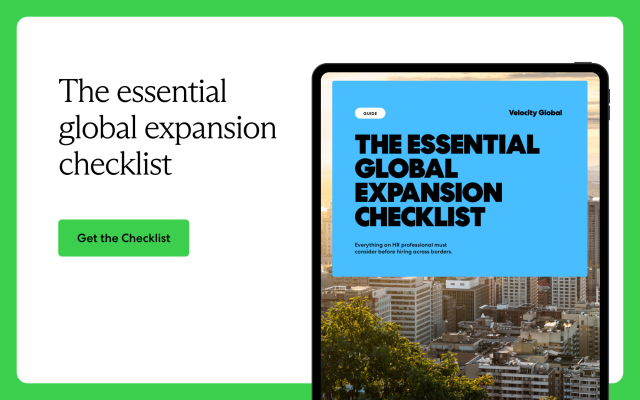Emerging markets are countries in the process of transitioning from lower-income economies to more industrialized, high-growth status with increasing global influence.
These markets are characterized by rapid economic expansion, which is often fueled by urbanization, the development of new infrastructure, and industry diversification.
The growing middle class in most emerging markets drives demand for consumer goods and services. While global expansion into emerging markets can offer significant business advantages—like growth potential driven by cost-efficient resources—companies can face considerable challenges, including regulatory complexities, fluctuating currency values, market volatility, and evolving legal frameworks.
Developed market vs. emerging market
Developed markets are economies with established infrastructure, stable regulatory environments, and high per capita income. Countries like the U.S., Japan, Germany, and Australia are examples, as they exhibit well-established legal and financial frameworks. Although this stability can reduce operational risk for businesses, the growth rate in developed countries is generally lower than in emerging economies.
Emerging markets show faster economic growth, driven by industrialization and increasing integration into the global marketplace. Countries with emerging economies are often characterized by growing consumer demand and expanding middle classes.
Characteristics of emerging markets
Emerging markets typically display expansion and business potential in the following ways:
Rapid economic growth
Emerging markets tend to experience higher economic growth rates than developed economies. Less-than-average per capita income can motivate rapid change, creating a desire for growth and the establishment of mature capital markets. These changes often result in rising productivity, new consumer demands, and expanded investments in infrastructure and technology.
Growing middle class
As those in countries with emerging markets rise out of poverty, an expanding middle-income population drives demand for consumer goods and services. This demographic shift gives global companies access to a stable and expanding customer base and drives steady growth in sectors like retail, healthcare, and financial services.
Urbanization
In emerging markets, large populations often relocate from rural to urban areas, seeking more significant opportunities. This shift can spark advancements in infrastructure (such as improved roads, utilities, and public services) as demand for housing and transportation grows. As a result, industries like construction and urban development that will support this transition stand to benefit.
Resource abundance
The presence of significant natural resources is a defining characteristic of emerging markets. These can include oil, gas, minerals, and agricultural products that attract considerable investment and spur economic growth but also bring challenges related to resource management, environmental sustainability, and geopolitical considerations.
Young and growing populations
While the birthrate is declining in many developed markets, emerging markets like India and Mexico possess youthful populations and an expanding workforce. While demographics like this can boost economic growth and innovation, investments in education, healthcare, and employment opportunities are still needed to support some 1.2 billion young people in emerging markets who will enter the labor market within the next decade.
Prominent emerging market economies today
The following emerging markets are expected to rank within the top 20 largest economies by 2035:
- China. China is characterized by a large, increasingly urbanized population and rapid economic growth. Key industries include manufacturing, technology, and e-commerce, supported by substantial infrastructure investment.
- India. India is known for its youthful population, high economic growth, and strong IT and services sector. The country’s expanding middle class drives demand for goods and services, making it a critical emerging market.
- Brazil. Brazil’s diverse economy, natural resource wealth, and prominent consumer market position it as Latin America’s largest emerging market. Key sectors include agriculture, manufacturing, and services.
- Russia. Russia’s economy has proven resilient and is projected to grow more quickly than other economies, even advanced ones. Oil exports and steady government spending characterize the country.
- Mexico. Mexico’s proximity to the U.S. and solid manufacturing base, especially in automotive and electronics, make it an appealing market for companies targeting North America. The country also benefits from trade agreements like the USMCA.
- Indonesia. With the fourth largest population in the world, Indonesia has been on a relatively steady growth path for over 30 years. The country is expanding in several sectors, including retail, health, education, telecom, and financial services.
- Turkey. Turkey’s location bridging Europe and Asia and its growing manufacturing and service sectors make it a valuable emerging market. The country also has a young population driving consumer demand.
Growing your business abroad? Get the essential global expansion checklist that reveals key insights on how to develop your global strategy, conduct market research, hire international employees, and ensure compliance at every step.

Advantages of doing business in emerging markets
Business expansion in emerging markets provides multiple advantages, including:
Access to growing consumer markets
Emerging market economies offer access to large and growing consumer bases, often driven by expanding middle-income populations, increasing urbanization, investments in infrastructure, and rising incomes (which means more significant disposable income).
This growth opens significant opportunities for businesses in sectors like retail, healthcare, housing, and financial service, as these markets have had limited access to goods and services. In other words, this untapped demand allows companies to grow their presence and reach new, previously underserved customers.
Cost-efficient labor
Emerging markets often provide access to a skilled but cost-effective labor force. Companies expanding into these markets can benefit from lower labor and production costs, making operations more budget-friendly than developed markets. This cost efficiency often translates to more competitive pricing and higher profit margins in global markets.
Abundant natural resources
Resource-rich emerging markets attract foreign investment and create business opportunities in industries like energy, agriculture, and raw materials. Companies operating in these regions benefit from cost-effective access to essential production inputs, often reducing logistics and supply costs. Still, this process requires thoughtful management around environmental responsibility and sustainability.
Economic growth and diversification
Emerging markets are known for rapid economic growth, driven by industrialization, urbanization, and increasing global trade. This translates to promising revenue growth potential for companies as these economies expand.
Expanding into emerging markets can also help companies diversify revenue streams beyond mature or saturated markets, supporting business stability during economic fluctuations and providing a cushion against shifts in consumer demand.
Innovation and a young workforce
With young, digitally savvy populations, emerging market economies foster innovation and adaptability in sectors like technology and e-commerce. This gives businesses unique opportunities to introduce new products and services tailored to an engaged, tech-focused audience. This adaptability can also strengthen a company’s resilience and inspire innovations that can later benefit operations in other markets.
Strategic partnerships and alliances
Companies entering emerging markets often benefit from partnerships with local firms, providing them with market insights, distribution channels, and support for navigating regulatory environments. These alliances are essential for building a stable presence in new regions.
Risks of doing business in emerging markets
While global expansion strategies are undoubtedly relevant to emerging markets, the latter has unique challenges. The rich potential for growth in emerging markets is accompanied by risks, including:
Political instability and corruption
Many emerging markets are in the process of reforming political, legal, and financial systems. Still, challenges can arise in countries with historical corruption (like bribery, extortion, and kickbacks) or where governments do not adequately protect property rights and pass laws that hamper trade. Further, regime change, civil unrest, and geopolitical conflicts can have extreme operational and financial repercussions.
Economic Volatility
Economic factors such as inflation, currency devaluation, and interest rates can drastically impact businesses expanding into emerging markets. High inflation, for example, can raise interest rates, thus increasing borrowing costs and limiting opportunities for the future. The economic volatility that often characterizes emerging economies can impact business costs, longer-term profitability, and financial outcomes.
Regulatory, legal, and security risks
Complex and inconsistent regulatory systems in emerging markets often include bureaucratic delays, corruption, and weak protections for intellectual property. Navigating permits, licenses, and other legal requirements can be challenging and may threaten a company's ability to safeguard its rights. Emerging markets may also experience higher incidences of crime, cyber threats, theft, and vandalism. Protecting employees, assets, and data from physical and cyber risks can require extra vigilance.
Infrastructure and supply chain challenges
Many emerging markets need more robust infrastructure, including transportation, energy, and telecommunications. These limitations can hinder operations, raise costs, and restrict market reach, often necessitating infrastructure investments or operational changes. Supply chains in emerging markets may also be less resilient, with risks related to raw material sourcing, transportation, and supplier reliability. Factors including natural disasters, political unrest, or trade barriers can significantly disrupt supply chains.
Challenges related to human resources
Cultural differences and social norms may complicate business operations in emerging markets, impacting workflow management and customer engagement. Companies must address language barriers and cultural sensitivities and build relationships with local stakeholders to succeed. Health and safety standards may be less regulated in emerging markets, posing risks to employees and customers. Prioritizing health and safety practices, training, and compliance with relevant standards helps mitigate liabilities and protect professionals.
Reputation risks
Companies entering emerging market economies may face reputational risks associated with environmental, labor, and ethical standards. Negative publicity from issues like environmental degradation or labor abuses can damage a company’s reputation, consumer trust, and investor confidence. Companies also face reputational and legal risks if they engage in corrupt practices or fail to comply with anti-corruption laws, such as the U.S. Foreign Corrupt Practices Act (FCPA).
How to navigate the challenges of operating in emerging markets
Despite these risks, many companies safely and successfully take advantage of emerging market opportunities. Strategies for addressing potential challenges include:
- Conducting thorough risk assessments
- Implementing risk management strategies
- Adapting business models to local conditions
- Building local partnerships
Expanding into emerging markets is complex and requires an experienced team. As a leading employer of record (EOR), Velocity Global helps businesses spearhead the above strategies, providing the highest levels of support for companies and the workforce that supports them.
We offer a full suite of global workforce solutions that handle all risk mitigation, local labor requirements, and compliance while you focus on growing your business. Our international capabilities in 185+ countries, unrivaled expertise, and dedicated service enable companies of all kinds to quickly and compliantly hire top talent in emerging markets. Learn more today.
Disclaimer: The intent of this document is solely to provide general and preliminary information for private use. Do not rely on it as an alternative to legal, financial, taxation, or accountancy advice from an appropriately qualified professional. © 2024 Velocity Global, LLC. All rights reserved.



